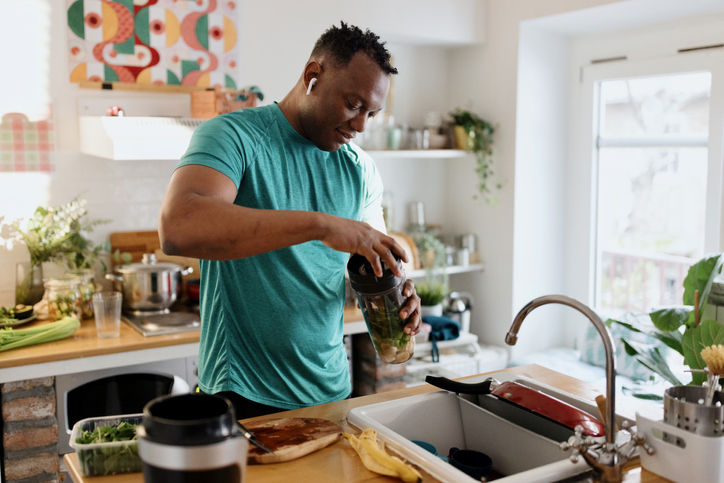 What’s the biggest barrier to healthier eating? Certainly, willpower and determination are factors. But according to Isabel Maples, a registered dietitian practicing in Virginia, the biggest challenge for many is planning.
What’s the biggest barrier to healthier eating? Certainly, willpower and determination are factors. But according to Isabel Maples, a registered dietitian practicing in Virginia, the biggest challenge for many is planning.
“The biggest barrier to getting a healthier meal on the table is the thinking ahead,” Maples said. “I can’t tell you the number of times I’ll get to the end of the day and think ‘What is for dinner?’”
Whether you’re preparing fresh meals or storing them to eat later, your appliances can help you get on the path toward healthy eating. We recently spoke with Maples and another registered dietitian, Marina Chaparro of Nutrichicos in Miami—to get their thoughts on the role appliances can play in healthy eating. Here’s what they had to say.
Think in advance: Dinnertime comes quickly, and you can anticipate those days when you’ll be short on time for planning by having go-to meals that can be prepared quickly. “You need to have at least three on hand that you can get on the table quickly,” Maples said.
Having healthy meals at the ready means you’ll need appropriate containers to make storage in your refrigerator or freezer easy and help control portion size. “Loading up on the right containers will help you have better habits,” Chaparro said. Containers that are divided into sections will make you put some thought into what you’re storing and eating. “It forces you to have three or four different foods with small portions. It’s great to take leftovers to work. It divides it nicely, so you’re forced to include different food groups.”
Blend in the goodness: A blender is a great tool for both adults and children who might not get enough fruits and vegetables in their diet. Chaparro has been pleasantly surprised by a recent small-size blender purchase, which she initially bought to puree fruits and vegetables for her 11-month-old daughter. “I love it, because it’s really small. You can use it to cook up some fast recipes like salsas or smoothies.”
If you’re using a standard blender, consider the size, Maples said. “That controls how much you put in. Don’t make too much or not enough.” Chia or flax seeds can add texture to a blended drink. “It can be as simple as some chocolate milk and a frozen banana,” Maples said.
Sometimes, texture can put family members off from eating certain vegetables. An immersion blender can help. “My favorite small appliance is an immersion blender,” Maples said. “I would use an immersion blender to smooth out the texture. I can add more vegetables and don’t have to be limited to a jar of sauce.” The immersion blender can also add a richer texture to cream-based dishes, but allow you to still take advantage of alternative ingredients, like low-fat milk. “One of my kids liked stew a lot, and that’s where my immersion blender came in. I could throw in extra vegetables.”
Tastier veggies: Vegetables can sometimes be tough to sell for picky eaters. Your oven can make them tastier. “Many people may not know how to make vegetables flavorful,” Chaparro said. “If you use the oven—roasting or baking at 400 degrees for short periods of time—it caramelizes.” Add olive oil and fresh herbs for more flavor. “I find that people who don’t traditionally like vegetables will eat vegetables if they’re roasted. It’s just a different flavor dimension and brings out some of the sweetness in the vegetables.” Maples encourages people who don’t want to take the time to chop the vegetables to buy a food processor for easier vegetable prep.
Try an air fryer: While she doesn’t currently own one, Chaparro said she’s interested in giving an air fryer a try. “It cooks food by using really hot air and leaves it crispy on the outside,” she said. “Some people like their chicken nuggets or french fries. You still get a comparable texture.”
Don’t forget the freezer: Use your freezer to preserve portions for quick meal and ingredient options later. “When my bananas are getting overly ripe, I’ll peel them and freeze them,” Maples said. “They’re great in a smoothie, or I can make banana bread.” She uses an ice tray to freeze fresh herbs in water. “You can pop them out and put them in a freezer bag.”
Keeping a healthy kitchen
Organization and preparation are essential to healthy eating, Chaparro said. “We might just think it’s about food and choosing healthy things, but it’s about creating that environment. Put the healthy things at eye level, especially the fresh fruits and veggies.” Make sure you have the right prep tools as well. Chaparro has her favorites, including a mandolin slicer that she uses to make zucchini, sweet potato chips and beet chips, and a noodle slicer, which she uses to substitute vegetables for traditional pastas.
Keeping healthy options in sight and within reach can even encourage family members to drink enough water, Maples said. That’s why she’s a fan of refrigerator water dispensers. “It makes it accessible,” she said. “If you have ice and there, it’s great and cheaper than using bottled water.” (Note: Make sure you’re changing the filter regularly, and that the replacement is not counterfeit!)
If you’re hungry after reading all of this, try this citrus and herb poached salmon recipe from recipe developer and “real foods advocate” Alyssa Brantley at EverydayMaven, who says her essential appliances for a healthy kitchen are a “good food processor, a good blender and either a slow cooker or electric pressure cooker.”




